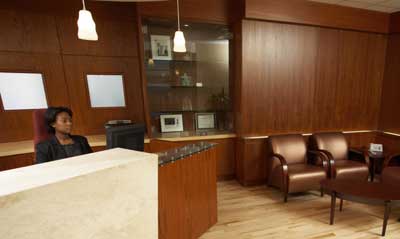By now you’ve probably heard of workplaces implementing unorthodox practices to improve employee satisfaction, such as nap rooms and chair massages.
These workplace perks are meant to improve employee health and positively impact overall workplace culture.
In conjunction with workplace perks like theses, business owners should be aware of how the physical office landscape itself affects staff and work processes.
[clickToTweet tweet=”3 reasons to rethink your office landscape” quote=”3 reasons to rethink your office landscape”]
A new generation of professionals and innovations in technology are impacting when, where, and how employees work and collaborate and, with this, a new emphasis is being placed on environments that promote health and productivity.
Despite significant changes to the office landscape, the one thing that hasn’t changed is the traditional desk workspace. Perhaps surprisingly, traditional sit-only desks can have a significant impact on an organization. A new report from Ergotron, the 2016 JustStand® Index: Getting Productivity Up & Moving, explores full-time employees’ attitudes towards sitting all day and how they believe it impacts their productivity and overall well-being.
According to Betsey Banker, wellness manager at Ergotron, there are several ways sitting all day adversely affects businesses overall. Betsey highlights three reasons to rethink the office landscape to improve employee health and productivity, and corporate culture.
1. It’s what’s inside that counts
There are many aspects of employee wellness that cannot be easily influenced at the office, such as how much sleep employees are getting or what they’re eating for breakfast and dinner each day. While employers should still encourage and promote healthy behaviors in a variety of ways, focusing on the physical office is a great place to start. It’s an area where employees spend over eight hours a day, five days a week, and the employer has complete control.
Employers can help break up sedentary time by adding opportunities for employees to engage in low-level activities — whether through the use of sit-stand workstations, walking meetings, or standing collaborative areas. Mounting evidence confirms that exercise will not undo the damage done by prolonged sitting, so employers should seek ways to help employees get on their feet in a more proactive way. By updating the office environment and providing a more active workplace, employers can more directly influence healthy behaviors.
2. Keep employees comfortable and productive
While the impact on the body of prolonged sitting has been well-documented in recent years, employers have been slow to connect the dots between extended sitting and the physical health of employees — or its corresponding effect on the overall health of an organization. Employees who sit for too long become restless and are forced to take breaks to manage discomfort or distraction. A staggering 58 percent of employees admitted to taking two to five breaks a day to relieve the discomfort of sitting.
Results of the index indicate restlessness from prolonged sitting is more disruptive to organizational productivity than visiting social media sites. While many employers are worried about cyberloafing— personal use of a company’s internet access while at work — and its impact on productivity, it’s clear that employees are spending more time moving around (61 percent) than cyberloafing (a combined 39 percent). What’s more, outside research suggests that, when interrupted, it can take a worker more than 20 minutes to get back on task.
While frequent movement should be encouraged, it should come from knowing the benefits of standing and striving for better health and wellness. It is critical for businesses to help employees have a voice in creating a work environment that fully supports their bodies and their ability to do their best work. One size does not fit all in terms of wellness opportunities, but the goal is always the same—keep employees comfortable and productive . Addressing the discomfort at the source is important to finding a solution that benefits the employee and the overall health of the organization.
[clickToTweet tweet=”Ways to Keep employees comfortable and productive. #workspace” quote=”Ways to Keep employees comfortable and productive. #workspace”]
3. Create a more positive work environment
Office culture is arguably becoming one of the major differentiators for recruitment and retention. Despite many organizations moving away from traditional cubicles to adopting a more open office floor plan, traditional desks are still in use and it’s leading to dissatisfaction. A majority (68 percent) of people must sit all day for their job and an overwhelming (61 percent) dislike or even hate sitting all day.
The discomfort caused from sitting too long is not only a distraction, but a silent attack on company culture, as it may impact employee stress levels, their ability to manage conflict, and their general mood and attitude. Happy employees are vital to any business’s success, and as there is a growing body of research around employee engagement and the link between employee satisfaction and profitability. Using sit-stand workstations to encourage movement can improve culture and health, helping companies retain and attract top talent — all while enhancing productivity.
The increased focus on employee wellness and satisfaction has pushed employers to invest in a variety of new perks and benefits to attract and retain employees. However, many companies have not fully examined the benefits of simply redesigning the office landscape to support a wider variety of work styles and to help incorporate more movement into the work day. Small office landscape adjustments can have a big impact on employee and company vitality.
Join Dana Manciagli’s Job Search Master Class® right now and immediately access the most comprehensive job search system currently available!



